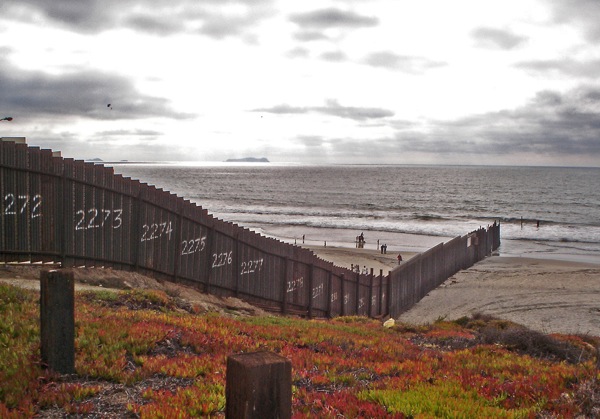Bush Environment Waivers Intact at Border
The border fence has become something of a political minefield for President Obama.
Jul 31, 202092.2K Shares1.9M Views
The end of the U.S.-Mexico border fence in California (Flickr: Bisayan lady)
Last July, presidential candidate Barack Obama took a stage in Berlin and told the adoring crowd that a wall erected between people — like that which divided the German capital for decades — would best be knocked down.
“The walls between the countries with the most and those with the least cannot stand,” Obama saidto roaring applause. “The walls between races and tribes; natives and immigrants; Christians and Muslims and Jews cannot stand. These now are the walls we must tear down.”
Illustration by: Matt Mahurin
Eight months later, hundreds of miles of border fence dividing the United States and Mexico are going up as planned. Despite pleas from some Democrats, environmentalists and local communities to halt construction until the wall’s impacts can be better examined, the Department of Homeland Security under President Obama has so far maintained the same border fence policies as the DHS under President Bush — a position reminiscent of the Obama’s continued supportof certain controversial Bush terrorism policies.
The status quo approach comes as something of a surprise. Although, as a senator, Obama voted in 2006 to approve the fence strategy, he saidon the campaign trail last year that he would “reverse” Bush-era fence policies in favor of a “better approach,” like deploying more border guards and installing better surveillance technologies.
More recently, his appointment of a vocal fence critic, former Arizona Gov. Janet Napolitano, to head the DHS signaled to many observers that fence policy would be soon to change. (Napolitano once mocked the border fence concept as futile, saying that “if you build a 50-foot-high wall, somebody will find a 51-foot ladder.”) At the very least, fence critics hoped that the Obama White House would reinstate dozens of environmental, public health and cultural heritage laws that the Bush administration waivedto expedite fence construction, including statutes designed to protect endangered species, drinking water and Native American graves.
Yet more than two months after both Obama and Napolitano were sworn in, those waivers remain in place. And they’ll stay there, officials say, at least until the 670-mile-long first phase of fence construction is complete.
“We’ve committed to 670 miles,” said Lloyd Easterling, spokesman for U.S. Customs and Border Protection, a branch of the DHS. “We’re going to go ahead and meet those goals.”
Easterling said “there was some question about stopping construction” when the new administration arrived, but the idea never materialized.
For environmentalists and congressional Democrats worried about the wall’s effects on local communities and ecosystems, the episode presents a dilemma. On one hand, these Obama supporters are optimistic that the young administration will eventually make good on its vows to break away from Bush’s border policies. On the other, they’re wary that the changes aren’t yet installed, allowing fence construction to continue through some of the most sensitive wilderness lands in the country. And of course, once a section goes up, it won’t be easy to get down.
For the administration, the fence is a political landmine that touches on a host of issues no less volatile than immigration, national security, landowner rights, the war on drugs and the environment. Complicating the debate, border violence has crescendoed in the last year, putting pressure on policymakers at all levels of government to prevent that crime from spilling further into the United States than it’s already come.
Still, some fence critics are beginning to challenge the White House to follow through on its pledges to examine fence policy more closely. In February, a group of eight border-state Democrats called on Obamato suspend fence construction until its impacts — cultural, political and environmental — could be scrutinized. The fence was “ill conceived” and “void of any meaningful input from the local communities,” the lawmakers wrote in a Feb. 10 letter to the president. “In an era of advanced technologies, the border fence is an antiquated structure that has torn our communities apart and damaged our cross border relationships.”
One signatory was Rep. Solomon Ortiz (D), who represents the Southeastern tip of Texas. In a telephone interview last week, Ortiz said that members of his office have met with Napolitano’s staff, adding that the new administration has been much more receptive than the last to lawmakers’ concerns about the fence. But Ortiz was also quick to reiterate his opposition to the waivers — and to the continued construction of the fence itself.
“It doesn’t sit well with the people in my district,” he said. “They don’t like it, [and] I don’t like it.”
Aaron Hunter, spokesman for Rep. Susan Davis, a Southern California Democrat who also signed the letter, said last week that the White House has not responded to the lawmakers’ concerns.
Easterling, the CBP spokesman, said the agency doesn’t have far to go to complete the first phase of construction. As of last week, he said, 613 of the 670 miles were up, and the remaining sections — most of which reside in California and Texas — should be finished by year’s end. Afterwards, he added, the administration will pause for a broader review before continuing to the next phase.
That there are fewer than 60 miles remaining in the first phase of construction has done little to stop fence opponents from pushing to have it stopped. Michael Degnan, Sierra Club lands representative, said that some of the unbuilt sections — including stretches in California’s Otay Mountain Wilderness Areaand the Lower Rio Grande Valley in Texas — are also the most isolated, and therefore the most worthy of protecting from development. The wall, environmentalists say, cuts straight through the heart of breeding corridors used by such threatened species as the jaguar, ocelot and low-flying cactus ferruginous pygmy owl.
“Some of the last places are also the most ecologically rich,” Degnan said.
Last week the Sierra Club, which endorsed Obama the candidate, urgedObama the president to halt all current and future fence construction “to review the full impacts and effectiveness” of the imposing barrier.
There are other concerns associated with the border wall. In August, flooding attributed to the fence damaged Arizona’s Organ Pipe Cactus National Monument, and another flood a month earlier caused millions of dollars of property damage on both sides of the border near Nogales, Ariz.
In 2007, 69 graves of the Tohono O’odham tribe were destroyed by fence constructionsouth of Tuscon, with fragments of human bone discovered in the bulldozer tracks, the tribe’s chairman testified before a congressional panel last year.
Fence critics contend that the waived laws — which include the Endangered Species Act, the Safe Drinking Water Act and the Native American Graves Protection and Repatriation Act — could have prevented such crises.
“If they’d followed the procedure and done the proper impact studies,” Matt Clark, of Defenders of Wildlife, said of the flooding, “they might have avoided a disastrous situation.”
Easterling said the CBP has “been very cognizant” of the wall’s effects, maintaining that the agency has conducted all the appropriate impact reviews. The waivers, he added, were necessary only to prevent lawsuits from hindering the process — a claim strongly disputed by environmentalists.
“There was really no reason for them to waive those laws unless they had reason to think they couldn’t comply with them,” Clark said.
Still, border fence critics have been much easier on the Obama administration than they were on President Bush. When the Bush administration announced a year ago that it was waiving roughly three dozen environmental laws, a number of powerful Democrats signed their support to a Defenders of Wildlife lawsuit contending that the waivers were unconstitutional — an effort spearheaded by House Homeland Security Committee Chairman Bennie Thompson (D-Miss.). Requests for comment from nearly all the supporters of that push — including Thompson, who was traveling on the border with Napolitano last week — went unanswered.
In another effort to protect the border environment, Rep. Raul Grijalva (D-Ariz.), who signed the Feb. 10 letter to Obama, introduced legislation in the last Congress to revoke the waivers — a bill that has yet to resurface this year. Calls and emails to Grijalva’s office also went unanswered.
Politically speaking, the silence is understandable. With the sharp increase in border drug violence making headlines nationwide, very few lawmakers appear willing to criticize the waivers or the fence for fear of being attacked for protecting ocelots above Arizonans.
The Washington Times neatly summarized this disdain for waiver opponents in an April 1 editorial, entitled “All the Pretty Mule Deer.” The paper argued that the fence is a vital, if imperfect, law enforcement tool protecting the U.S. from a tsunami of criminality.
“When floodwaters are approaching, you begin filling sandbags to buttress the levee,” the Times wrote. “You do not go to court to debate what type of sand to use.”
Still, fence critics hope the Obama administration will step in sooner than later with a broad and revamped strategy for tackling the many thorny border issues — a strategy they hope will move away from the current reliance on an intrusive physical barrier dividing border communities and scarring delicate landscapes.
“Putting up a fence,” said Hunter, “is not a comprehensive immigration policy.”

Hajra Shannon
Reviewer
Hajra Shannona is a highly experienced journalist with over 9 years of expertise in news writing, investigative reporting, and political analysis.
She holds a Bachelor's degree in Journalism from Columbia University and has contributed to reputable publications focusing on global affairs, human rights, and environmental sustainability.
Hajra's authoritative voice and trustworthy reporting reflect her commitment to delivering insightful news content.
Beyond journalism, she enjoys exploring new cultures through travel and pursuing outdoor photography
Latest Articles
Popular Articles

